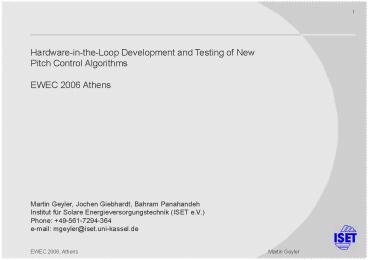Forschung und Entwicklung PowerPoint PPT Presentation
1 / 19
Title: Forschung und Entwicklung
1
Hardware-in-the-Loop Development and Testing of
New Pitch Control Algorithms EWEC 2006
Athens Martin Geyler, Jochen Giebhardt,
Bahram Panahandeh Institut für Solare
Energieversorgungstechnik (ISET e.V.) Phone
49-561-7294-364 e-mail mgeyler_at_iset.uni-kassel.d
e
2
Project Objectives
Development of advanced pitch control algorithms
for load reduction in large wind turbines
Project Partners
- Individual blade pitch control
- compensation for unsymmetrical inflow conditions
due to turbulence or deterministic effects - active damping for tower and blades
- Modular controller design
- Development of safety algorithms
- stability monitoring,
- handling of sensor faults
- Identification of requirements for the pitch
system using a Hardware-in-the-Loop test bed
setup - dynamics,
- loads, wear,
- power consumption, thermal losses,
- load sensors
- communication requirements
3
Control Problem
Schematic of Control Loop
4
Test Bed Schematic Overview
5
Test Bed Control Concept
6
Test Bed Laboratory Setup
Controller Rack with Simulation PCs
Pitch Drive Inverter Cabinet
Load Drive Inverter Cabinet
Host PC
Load Machines
Pitch Motors
7
Real-Time Simulation Overall Wind Turbine Model
Block structure of Simulink model
8
Real-Time Simulation Mechanical Model (1)
Multibody approach
- 14 rigid bodies connected by joints
- Universal joints with torsional stiffness and
damping representing flexibility of the structure - Revolute joints with external torque input
representing actuators
- fully recursive algorithm Method of Articulated
Inertia - tree-like structure is exploited
- avoids need for inverting large mass matrices
- O(N) method computational effort increases
linearly with number of DOF
- Mass forces (gravity, inertia) inherently
included by the algorithm.
- Solver 3rd-order Runge-Kutta solver at 1ms time
step - ca. 450 µs calculation time on Athlon 4000 PC
Mechanical model
9
Real-Time Simulation Mechanical Model (2)
- Parameters for multi body model were calculated
using a optimisation algorithm to find a best fit
to a given finite elements (FE) model
- Step Optimisation of joint locations in order to
allow for best representation of first 3 mode
shapes
- Step Optimisation of stiffness parameters and
joint twist angles in order to fit eigen
frequencies and mode shapes
- Validation Comparison of static deflection due
to a constant line load (blade) or constant tower
top force
1st mode and static deflection of simplified
blade model with 2 rigid sections Comparison
with FE model
Mechanical model
10
Real-Time Simulation Pitch System Model
Load torque reference values for load drives will
include the following effects
- pitch gear ratio 11000
- tooth clearance at fast side of pitch gears
- blade bearing friction
- DRE/CON-formula for large bearings
- MR µD/2 k M blade root
- Four point contact bearings
- µD 0.006, k 4.37
- Components for axial and radial force have been
neglected.
- changing inertia due to blade deflection
inherently included by mechanical model
Example simulation for pitch load situation in
turbulent wind conditions
11
Real-Time Simulation Aerodynamic Model (1)
- Blade Element Momentum Theory (BEM)
- 12 blade elements per blade
- semi-empirical corrections state-of-the-art
implementation of - dynamic inflow
- yawed inflow
- dynamic stall
- total 240 aerodynamic states
- Solver simple Forward-Euler integration at 1ms
time step - calculation time ca. 45 µs on Athlon 4000 PC
12
Real-Time Simulation Aerodynamic Model (2)
- Dynamic Inflow Model (ECN)
- Local inflow condition at blade sections depend
on free wind speed and load situation of the
rotor in a dynamic manner. - Example Overshoot in blade root bending moment
for fast step on pitch angle
Tjaereborg Experiment
Simulation
13
Real-Time Simulation Aerodynamic Model (3)
- Dynamic Stall Model (Beddoes-Leishmann-Type)
- Effect dynamic lift forces can be considerable
bigger than predicted by stationary cL-?-curve
for fast changes in pitch angle.
Simulation
Measurement (Risø)
14
Real-Time Simulation Turbulent Wind Field Input
(1)
- 2-D turbulent Wind Field is simulated off-line
and read from a file during real time simulation
? reproducible time series - 8 x 8 points in the rotor plane,
- linear interpolation
- only mean wind direction
- Method by Mann
- wind field is assembled in a 3D-box by means of
inverse FFT - Fourier Coefficients calculated from
spectral-tensor ( only ?11 used ) - frozen turbulence dimension L1 is used as
time axis
- Parameter fitting to Kaimal spectrum
- Input parameters
- mean wind speed,
- mean wind shear,
- turbulence intensity
- Extreme gust events can be embedded into
stochastic turbulent wind field - Most likely gust shape calculated from
correlation matrix R and a given criterion e.g.
total jump in wind speed at given location
15
Real-Time Simulation Turbulent Wind Field Input
(2)
Averaged auto-power spectrum for simulated wind
fields
Example for extreme gust event Criterion ?v 10
m/s, ?t 16 s, location
16
Real-Time Simulation Visualisation
- 3D visualisation tool for motion and load
situation of simulated wind turbine - VRML based
- Visualisation coupled to real-time simulation via
TCP/IP based communication channel
Visualisation with VRML
17
First Results (1)
- Algorithm for yaw and tilt moment compensation
implemented and tested
- (simulated) 1p component in flapwise blade root
bending moments is almost cancelled,
- pitch drive rating seems sufficient for producing
required 1p cyclic pitch offsets, however,
considerably increased motion as compared to
normal collective pitch operation
- simple fuzzy scheme for supervision and
controller gain adjustment
simulated reduction in 1p component of flapwise
blade root bending moment
18
First Results (2)
Measurement of Pitch Drive Load Torques
19
Conclusions
- Hardware-in-the-Loop test bed for Pitch Drives
has been developed and successfully taken into
operation.
- Real-Time Simulation Environment allows for
providing realistic load conditions as well as
all required feedback signals to the tested Pitch
Control System.
- First simulation results and measurements for a
Yaw- and Tilt-Moment Compensation Controller
(Proof-Of-Concept).
- It is believed, that the test bed will greatly
improve the understanding of the system aspects
of advanced pitch control strategies.
Thank You.

